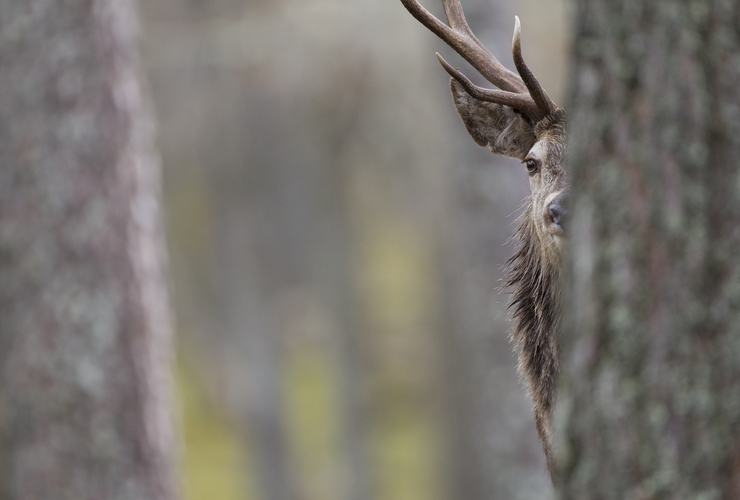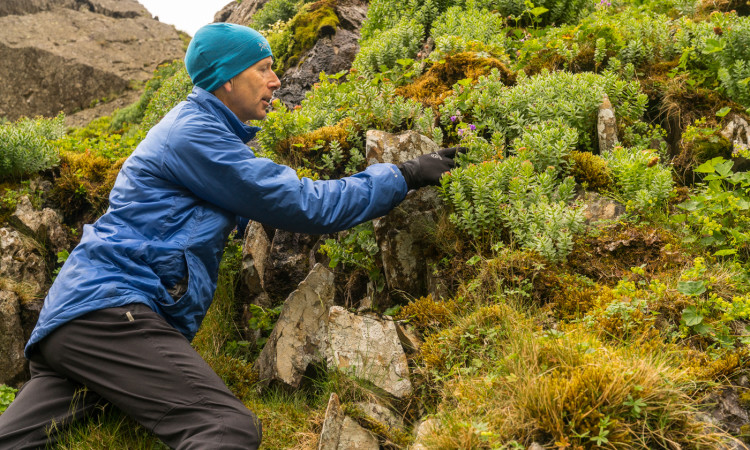Too many deer and too few trees
Mike Daniels, the Trust’s head of land management, wrote this plea for stronger regulation of deer numbers for the Royal Scottish Geographic Society in 2015.
The roaring stag, monarch of the glen, is a Scottish icon, one of the ‘Big Five’ in this Year of Natural Scotland. But like any stereotype, this is a single dimensional façade - beneath which lies a more complex and troubled story. A story about collateral damage wreaked on the environment in pursuit of antlered trophies for the wall: declining mountain woodlands, the near extinction of natural tree lines, trampled blanket bogs and the steady loss of biodiversity. A tale of ever increasing deer numbers, spiralling costs to the public purse, and the ceaseless march of deer fences across Scotland’s hills and glens. And finally, the cries of threats to ‘traditional’ jobs that any attempts to reduce this burgeoning population brings.
The deer themselves are the innocent party, doing what comes naturally to them – feeding, breeding and seeking shelter. Native red deer are an essential part of Scotland’s ecology, but as their natural predators (wolves, lynx and bears) have been exterminated, their populations are now entirely in the hands of landowners. Since the Victorian rise of the ‘shooting estate’, for most of Scotland any incentive to mimic nature and her natural predators has long gone. Rather, the emphasis has been on increasing numbers encouraged by estate agents who add £40-50,000 to the valuation for each ‘shootable’ stag.
Inevitably this has led to growing populations. Since red deer counting first began in the 1960s the estimated Scottish population has nearly trebled from 150,000 to over 400,000. As well as exerting an environmental toll, this rising population comes with a heavy price tag. Increasing numbers of vehicle collisions, damage to environmental protected sites and kilometres of deer fences – all cost the public purse tens of millions of pounds annually. For the deer, there is a high price to pay too. Annual deaths of thousands of deer from starvation and exposure - the result of confining ever larger numbers to ever smaller unfenced areas – is a common occurrence in Scotland in late spring.
Since red deer counting first began in the 1960s the estimated Scottish population has nearly trebled from 150,000 to over 400,000
Incredibly this situation is underpinned by legislation. Close seasons restrict when deer can be culled, to maximise trophy value and prevent ‘disturbance’ the rest of the year (not something natural predators would recognise). In Scotland, unlike most of Europe, cull targets are entirely voluntary and there is no sanction for failure to meet them. Even where an internationally protected environmental site is being damaged by deer the authorities can only ‘encourage a voluntary management agreement’. And within such an agreement any deer reduction must be balanced against its potential socio-economic impact on the hunting interests of neighbouring estates.
Calculating such socio-economic impact is a challenge. There is not one estate owner in Scotland who would claim to have made their wealth from deer shooting. Rather you need to be wealthy to own a shooting estate. As to balance, Scotland’s natural environment – its woodlands, its peat bogs and its heaths - have been heavily impacted and damaged by deer for centuries. They are way out of balance. Any swing of the pendulum needs to repair this damage and improve the habitat that the deer depend on for food and shelter.
Yet when any attempts to reduce deer populations are made they are met with howls of protest from neighbouring shooting estates. Dramatic claims that a ‘traditional’ way of life is threatened and that local jobs will be lost are whipped into a local and sometimes a national media frenzy. Such storms have raged around Creag Meagaidh, Glenfeshie, Mar Lodge and Quinag over recent years.
Such claims ignore three inconvenient truths. Firstly, any reductions merely bring populations back to where they were a few decades ago. Secondly, estates involved in these reduction culls wish to retain deer – not exclude them through fencing. Thirdly, not a single job has been lost, with estates involved in reduction culls retaining or increasing their deer management employment. As to ‘tradition’ it is unlikely the Victorians would recognise the way shooting estates operate today: high deer densities, hills covered with deer fences and bulldozed hill tracks, and off-road vehicles taking stalkers and their guests to remoter areas previously only accessible on foot.
Similarly, any attempts by governments to impose more sustainable management on sporting landowners have met with stiff resistance. The latest attempt in 2010, to introduce a statutory code for deer managers, was watered down to a voluntary one amid claims it would infringe the property and even the human rights of shooting estate owners. Instead they argued for the retention of the ‘voluntary approach’ – the right to manage deer as they wanted.
Meanwhile the deer population continues to rise, more land continues to be fenced off and damage to the natural environment goes on. Surely it is time to admit the voluntary system doesn’t work, that self-regulation is clearly failing, and that we need to re-think the way deer are managed in Scotland.
